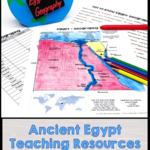Engaging and Inspiring Ancient Egypt Teaching Resources for 5th-8th Grade
One of my absolute favorite units to teach to my middle schoolers is the Ancient Egypt unit. The time period of the ancient Egyptian civilization is fascinating because of how they organized themselves financially, socially, and politically. I wanted to spark the same excitement in my students, but I quickly learned that to them, the information was just a bunch of facts. So, I set out to create Ancient Egypt teaching resources that are informative but also hands-on, bringing ancient Egypt alive! Using interactive notebooks, we will dive into this ancient civilization with activities that are designed to engage, educate, and inspire. Find out how I use these Ancient Egypt teaching resources with my students and how you can use them with your students, too!
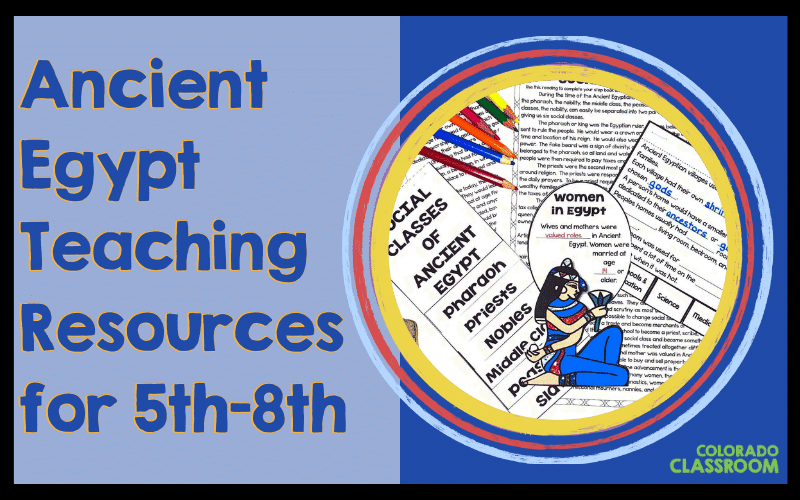
Ancient Egypt Teaching Resources Bundle
Before I dive into how I teach ancient Egypt, let me introduce you to my go-to ancient Egypt teaching resource – the Interactive Notebook on Ancient Egypt. It’s a game-changer that includes 11 lessons jam-packed with excitement, knowledge, and hands-on activities.

I provide you with lesson plan suggestions, slideshows, full-color examples of the activities, a wide variety of foldable products, engaging readings, review games, and activities that will spark curiosity within your classroom.
From the comforts of your classroom, your young historians will explore the geography of Egypt and the ins and outs of ancient Egypt’s governments, dynasties, social life, hieroglyphics, religion, rituals, and landmarks! This unit makes Ancient Egypt unforgettable for your learners!
Now that you know where to find the whole unit in one place, I want to break it down into the bite-sized lessons and activities you will use with your students. There is a lot to cover in these teaching units, so taking a thoughtful approach is key to facilitating understanding.
Buckle up; let’s dive into the wonders of ancient Egypt!
Ancient Egypt Teaching Resources for Geography
To captivate my students, I always want to lay a solid foundation for our journey into Ancient Egypt. This always begins with geography! We explore the landscapes that set the stage for this historical period. As my students visualize the deserts, cruise along the Nile River, and sail the Mediterranean Sea, a discussion unfolds, diving into the historical significance of the land and the impact of climate on the Egyptians’ way of life.
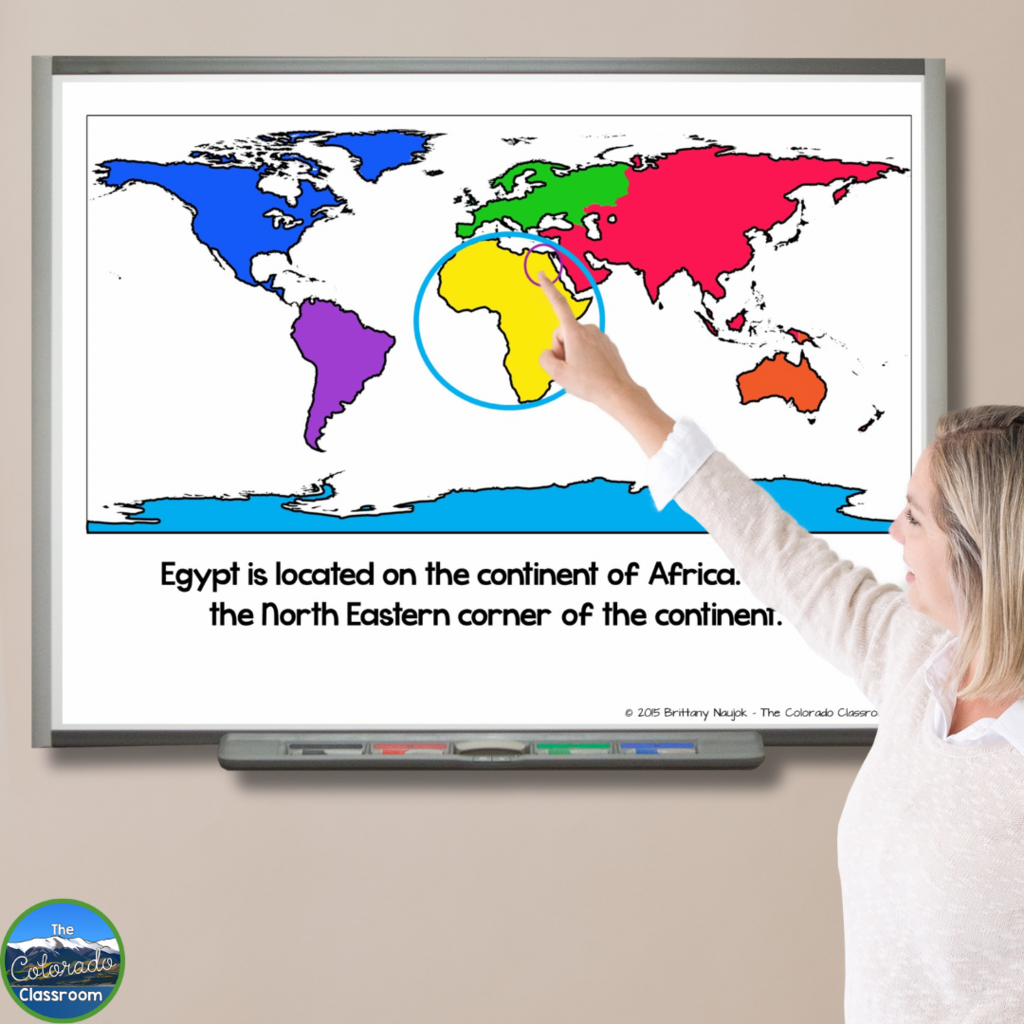
To kick off this lesson, I pass out a blank map of Egypt along with cloze notes to each student. Guiding the class through the exploration, I use a slideshow with similar maps and info called, “Get to Know Egypt – Geography.”
This interactive approach allows me to explain various land features and address any questions that arise. Once the notes are complete, we turn our attention to the blank map.
I’ve found this visual tool to be highly effective, especially when colored in and labeled. Depending on the student’s abilities, I adapt the completion of the map—whether it’s a small group effort, paired work, or independent completion using their notes. Flexibility is key to tailoring the approach to diverse learning styles.
To reinforce their understanding of Ancient Egypt geography, and the other topics to come, I introduce a two-column note page. This concise tool aids students in focusing on the most critical details. While I also offer cloze notes, some learners may find the two-column format more beneficial. The goal is to provide resources that cater to the varied needs of our budding historians!
Ancient Egypt Teaching Resources for Vocabulary
Next up, it’s time to embrace the vocabulary of Ancient Egypt! Once my students are confident with the geographical groundwork, the next layer in our foundation is building vocabulary. Recognizing that some words may be unfamiliar is essential to taking the next step to help your students learn their meanings before moving on. This allows the students to experience the vocabulary words being used in context through the remaining lessons.

The journey begins with us previewing the 12 vocabulary words for the unit. As we preview each word, we practice pronouncing them, discussing their meanings, and exploring any familiar or similar terms. This process encourages students to break down the words into chunks, ultimately fostering a deeper understanding of the words.
Once the class warms up to the vocabulary, I hand out the foldable Flash Card Holder. This will create a place for students to store vocabulary cards for all the words. They fit inside an interactive notebook and create a tool students can reference throughout the unit.
Next up, I provide vocabulary flashcards with the words and definitions pre-typed. Students cut these out, fold them along the dotted line, and tuck them into their holders. In future units, when we come across one of these words, we always come back to these cards to review the meaning.
Applying the Vocabulary
Moving beyond memorization, I shift the focus to analyzing and applying the words. Students select a vocabulary strategy—be it Four-Fold, Frayer Diagram, or Word Map—to dive into the meanings, incorporate them into sentences, and explore synonyms and antonyms related to each term. This approach encourages individual exploration, partner collaboration, or small group engagement, allowing students to choose the method that fits best with their learning style.
Ancient Egypt Teaching Resources for Timelines
Wonder what’s next in our Ancient Egypt lessons? Now that my students have a solid grasp of geography and vocabulary, we move on to the next layer of our exploration, which is the Ancient Egypt Time Line.
Constructing the Ancient Egypt Time Line
With a clear sense of our place in history and key vocabulary at our disposal, the focus shifts to providing an overview of the important events that shaped Ancient Egypt. To help students visualize these events in history, I turn to the trusty timeline. Timelines are a powerful tool that not only organize historical moments but also become a reliable reference as my students begin to connect different civilizations and historical events into the larger picture of history.
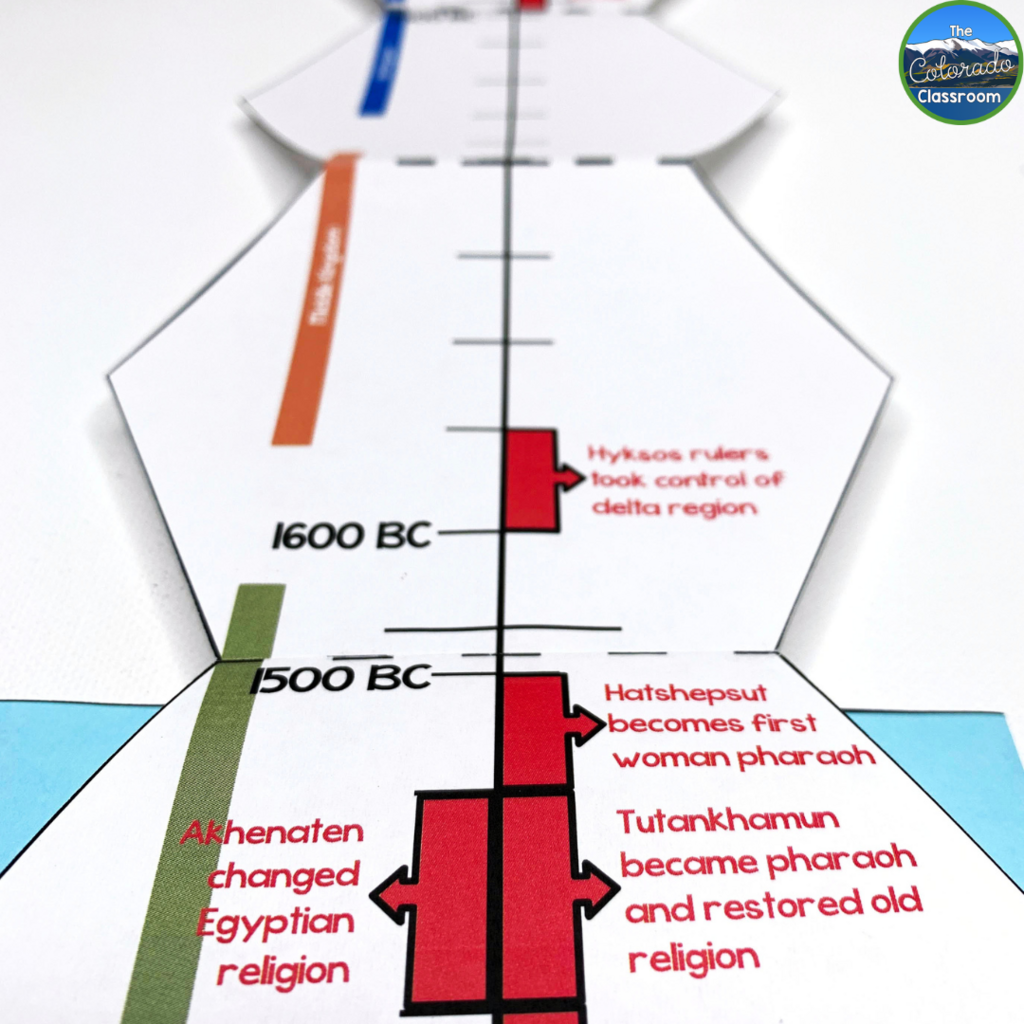
Students love creating their unit timelines. This hands-on activity engages them far more than a traditional timeline worksheet. Plus, they are more likely to remember these key events and their order since they are creating the timeline and not just filling in dates.
I make sure to point out B.C. and A.D. in our timeline. I help my students understand B.C. time, where years descend as they approach A.D. and then begin to ascend after A.D. Taking a little extra time to ensure everyone understands, is crucial to laying the foundation for continued success throughout this entire unit. Even if this is not your first unit of the year, students can always use this reminder.
With our timelines neatly assembled, the real magic happens. I guide my students through the key events of Egypt’s rich history using the following Ancient Egypt teaching resources. We seamlessly add ages and events to their spots on the timeline.
In this process, timelines become more than just chronological records. They become visual aids that help our students connect the dots and see the flow of historical events.
Ancient Egypt Teaching Resources for Government and Dynasties
As we journey deeper into the heart of Ancient Egypt, it’s time to unravel the layers of the culture. Our next destination is the systems of government and dynasties that shaped this fascinating civilization. This leg of our exploration typically spans at least three days, allowing for an in-depth understanding to form.
The Upper, Lower, & United Egypt Foldable
On the first day, I guide my students through the creation of the Upper, Lower, & United Egypt foldable. This activity gets them diving into how Egypt was divided and how the governments in each area were different and similar. This hands-on activity adds a tactile dimension to our learning as they cut, assemble, and add it to their notebooks. As we enter into discussion, students complete cloze notes, a scaffolded approach that ensures understanding. I sprinkle in Socratic questioning, encouraging students to think critically about this topic.
The Old, Middle, and New Kingdom Foldable

With the foundational knowledge set on day one, we move to the next layer, which is the Old, Middle, and New Kingdom foldable.
Following a familiar pattern, we engage in discussions and fill out the notes. This approach reinforces understanding of how the governments of Egypt changed over time, while also accommodating diverse learning styles.
To build comprehension and creativity, I assign a writing and illustration activity as homework. Students are tasked with choosing a kingdom—Old, Middle, or New—and write about why they would enjoy living in it. The accompanying illustration provides an image of what they envision life would look like.
This is one of my favorite activities in the whole unit because it gives me a glimpse into what is most interesting to my students in our studies. As a lover of all things history, it’s always fun for me to see what fascinates my students!
Ancient Egypt Teaching Resources for Dynasties
Navigating Ancient Egypt’s dynasties opens a realm of historical richness. With a collection of 32 dynasties, it can be difficult for students to truly grasp the uniqueness of each one. While they learn that there were 32 dynasties, in my classroom, we focus on the 12 dynasties that had the most significant historical influence in shaping the development of Egypt.

To dive into this fascinating tapestry, I guide my students through a strategic thinking map exercise. In this journey, they are empowered to choose five of the most important dynasties in Egyptian history. I challenge my students to explain and support their choices.
Once prepared with their chosen dynasties and well-reasoned justifications, my students step into the spotlight of classroom discussion. The sharing session transforms into an exchange of ideas and occasionally sparks heated debates as diverse perspectives collide.
This not only enriches their understanding but also creates a sense of collective exploration. Over the years, I’ve found that sharing diverse justifications helps to expose everyone to new perspectives and viewpoints, which is always welcome in my room!
Ancient Egypt Teaching Resources for Social Life
Embarking on the exploration of Ancient Egypt’s social world with these Ancient Egypt teaching resources piques my students’ interest! Here’s how we navigate this captivating journey through the history of Egyptian social life.
Unveiling the Layers of Social Classes
The excitement brews as we set the stage for one of my students’ favorite lessons—the exploration of social classes in Ancient Egypt.

To kick off, we start by creating a flipbook, a visual to help students understand the six social classes of Ancient Egypt. I love that the format of this flipbook provides students with a visual reminder of the social classes in order.
With the flipbook in hand, my students partner read the article “Social Classes in Egypt.” As they read through the text, they complete notes in their flipbooks, coloring and adding drawings to reinforce their understanding.
Depending on time constraints, I either collect and review the flipbooks or we go over them as a class. If we do have time, I love going over them as a class because this helps to deepen student understanding. The social classes of Egypt are incredibly varied, and complex. It’s a topic worth discussing in detail if time allows!
The following day, we return to the brief section about Egyptian women in the “Social Classes in Egypt” article. Ready with scissors, glue, and enthusiasm, my students cut, assemble, and complete the Women in Egypt foldable based on their readings. This leads us to explore the similarities and differences between the roles of women in Egyptian society compared to our own or other cultures we’ve studied.
Our journey through Ancient Egypt’s social life continues with the assembly of the “Life in Egypt” foldable on the third day. Once again, my students read an article to learn about daily life in Ancient Egypt. They fill in the notes inside the foldable, and to ensure clarity, we review the key points together.
Reflecting and Assessing with a 3-2-1 Review
As a wrap-up our study of Ancient Egyptian social classes, we engage in a 3-2-1 review. This is a fun review activity using a pyramid graphic organizer. Students write down three facts they believe are most important in the bottom spaces, define two vocabulary words in the middle row, and express their curiosity with one thing they’d still like to learn about the social life of Ancient Egyptians at the pyramid’s peak.
Ancient Egypt Teaching Resources for Hieroglyphics
Revealing the mysteries of hieroglyphics is a lesson my students eagerly anticipate! Here’s a glimpse into how we turn the exploration of hieroglyphics into an engaging and hands-on adventure. The excitement builds as my students embark on the first step, which is cutting and assembling mini-books on this topic. This serves as their trusty companion for note-taking as they unravel the secrets of hieroglyphics. The anticipation is high as they prepare to decode the ancient script that once adorned the walls of Egypt.
Hieroglyphics and the Alphabet

With mini-books at the ready, my students read the captivating article “Hieroglyphics” along with a copy of the Hieroglyphics Alphabet. They fill out their mini-book notes as they learn about this ancient script. To ensure a smooth start, I model a couple of pages, offering guidance on deciphering the hieroglyphic code. Then, I weave through the room, actively checking in on their progress.
To deepen their connection with hieroglyphics, I introduce a playful element. Partnering up, my students engage in mini-games like Hieroglyphic Hangman or another word guessing game. Instead of letters, they decipher hieroglyphics—a delightful twist that infuses fun into learning.
As we near the conclusion of this lesson, we transition to the Hieroglyphics Activity. Students are encouraged to write their names in hieroglyphics. A process I accompanied with a thoughtful discussion on the power names held in Ancient Egypt. The activity prompts a reflection on the potential power in their own names.
Ancient Egypt Teaching Resources for Religion
Unlock the secrets of Egyptian religion with a touch of creativity with these Ancient Egypt teaching resources!
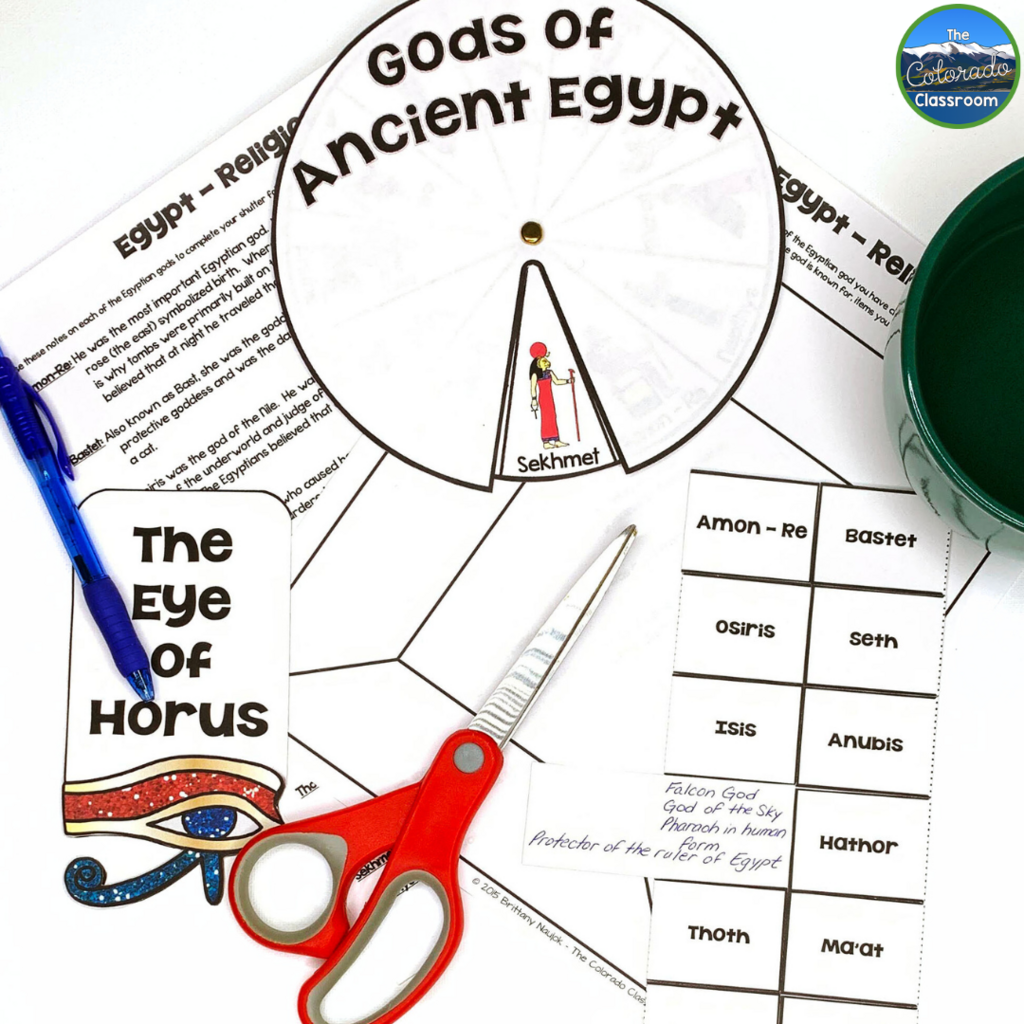
To ensure lasting impressions, I kick off our exploration of religion with visual notes. Each student creates a Gods of Ancient Egypt wheel, a visual tool for the 12 gods we will be learning about in this civilization. Once they are finished with the wheel, I have them create the second foldable for this topic. As a class, I tell the stories of each of the gods, and the students fill out their notes.
Next up, accountability meets artistic expression! The Picture Frame Activity is one of our next Ancient Egypt teaching resources on this journey. Students select a god that stands out to them, channeling their inner artist to draw the deity in the frame’s center. They then illustrate the god’s name and share three intriguing facts. These personalized frames become artifacts displayed in our classroom.
Encourage students to dive into the personal significance of their chosen god. This not only fosters a deeper understanding but also sparks lively discussions about the different perspectives of each deity.
For an additional layer of insight, we work on “The Eye of Horus” foldable. Although no formal reading is provided, I’ve discovered the magic of storytelling. As students fill out the notes, I narrate the tale, unraveling the mysteries behind this ancient Egyptian talisman.
Ancient Egypt Teaching Resources for Burial Rituals
Engaging my students through burial rituals never fails to spark curiosity and fascination. After all, who can resist the allure of mummies?
Our lesson begins with the unveiling of the Mummy Foldable. It’s an interactive guide with a simple 10-step process of preparing and mummifying a body. Students eagerly cut, fold, and glue this informative piece into their interactive notebooks, creating a handy reference for the future.
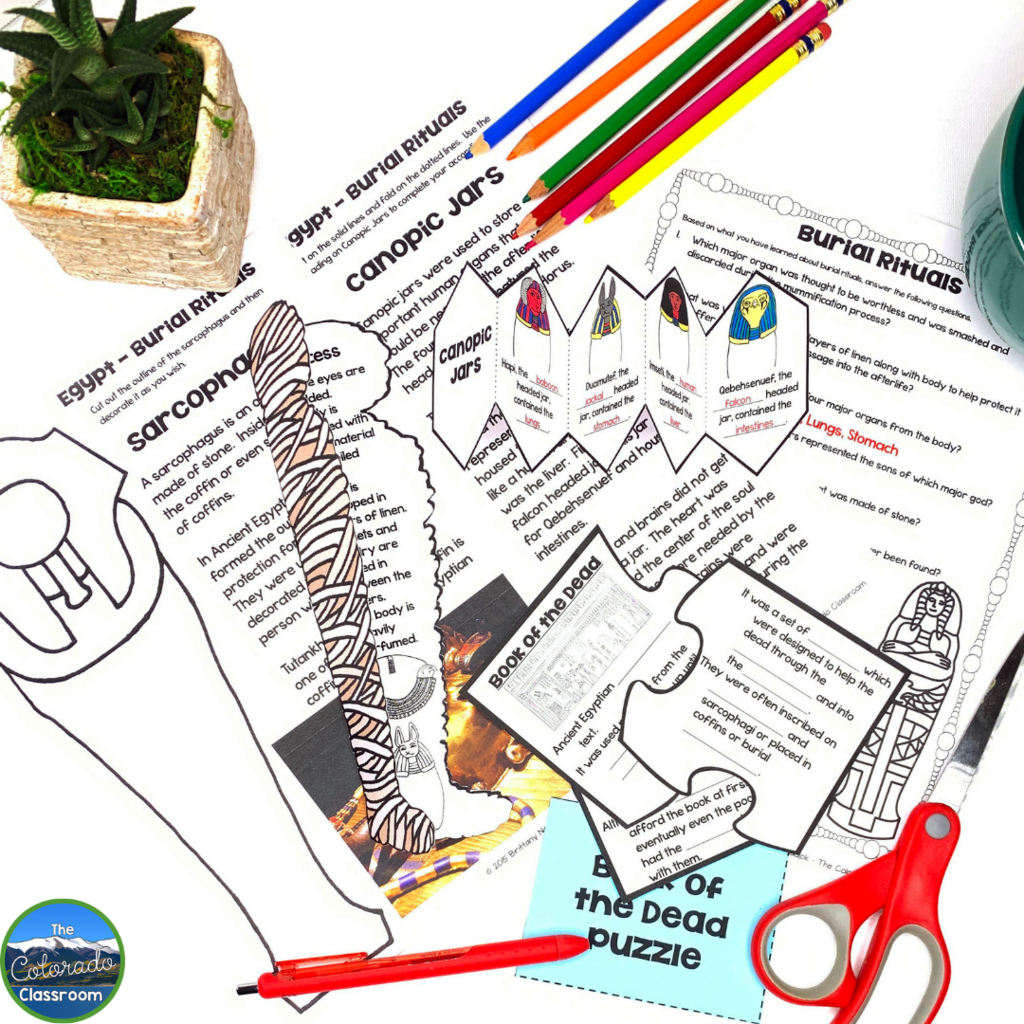
Next in our Ancient Egypt teaching resources lineup is the Canopic Jar Foldable. This is an interactive exploration into the vessels that held essential organs during mummification. Students pair up for a partner reading of the accompanying text. While reading, they also fill out their accordion-style Canopic Jar Foldables.
I always get a kick out of witnessing their reactions as they discover the contents of these jars! Promote discussion by encouraging students to share their reactions and insights about the Canopic Jar reading. This not only fosters a collaborative learning environment but also provides a safe space for perspectives.
Our burial lesson also includes the Book of the Dead Puzzle, which is a collaborative, whole-class activity. We navigate the mystical passages of ancient beliefs. As students cut, assemble, and glue the puzzle pocket into their notebooks, I guide them through the process of filling out their notes on the puzzle pieces, weaving in questions to tap into any prior knowledge they might already have.
Ancient Egypt Teaching Resources for Landmarks
Navigating Egypt’s historical landscape becomes an exciting adventure as we start to study iconic landmarks. To set the stage, my students cut and glue a new map of Egypt into their interactive notebooks. This serves as our visual compass, guiding us through Egypt’s key locations.
As we dive into an introductory reading as one of the Ancient Egypt teaching resources, our eyes look over the map for key locations. We also revisit the comprehensive map we color-coded and labeled at the beginning of our unit. We compare both maps and take note of how Egypt has developed.
Encourage students to annotate their maps with personal insights or questions as they make comparisons. This builds a sense of ownership and curiosity throughout the exploration.
Unveiling Wonders of the Pyramids, Sphinx, and Temples

Our journey gains momentum as we unravel the mysteries surrounding Egypt’s architectural marvels—the Pyramids, the Great Sphinx, and the temples of Karnak, Luxor, and Hatshepsut. Each landmark is accompanied by an interactive foldable. Students love creating these landmark foldables and adding tidbits of historical facts about each one. This transforms the activity into a storytelling session, making the learning experience more vivid and memorable.
Complementing the foldables, students immerse themselves in these Ancient Egypt teaching resources and creative activities, such as coloring pages and interactive notes on the Valley of the Kings. These activities add a touch of artistic exploration to our historical journey.
The lessons come together in a reflective writing activity where students share their perspectives on the most awe-inspiring landmark. This, once again, allows our students to include a personal touch into their exploration of Egypt’s history, building their ownership.
Encourage your students to express not just admiration but also curiosity in their reflective writing. What questions do they still have about these landmarks? This sparks a continuous journey of inquiry and engagement.
Ancient Egypt Teaching Resources for Review
Once we have explored each of the topics in the Ancient Egypt unit, it’s time for your students to showcase what they know! I usually hand out the study guide about a week before I give the test. This gives my students plenty of time to review and ask any questions that may pop up along the way. I also make sure to review the right answers to the study guide, so they can be set for studying.
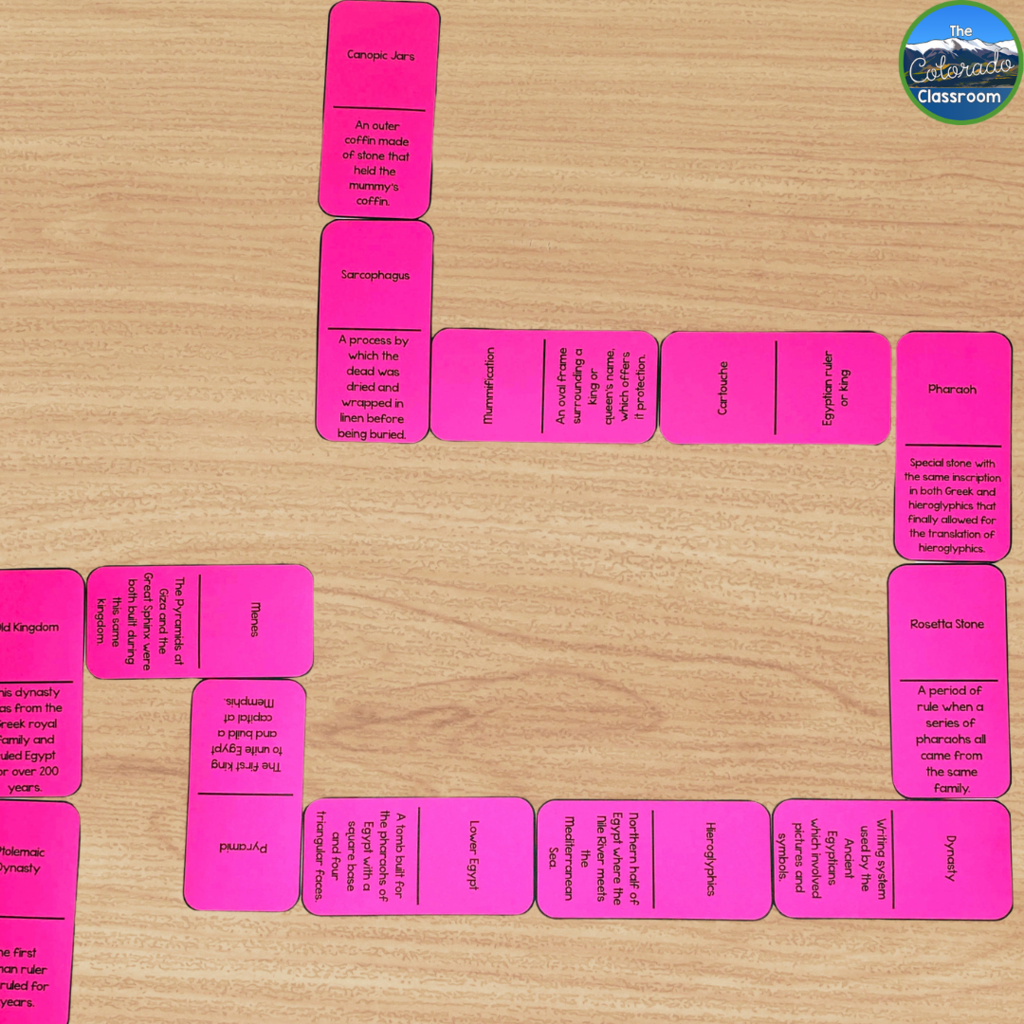
While they are reviewing the study guide outside of class, I have a couple of review games we play in class. The first one is Ancient Egypt Bingo. I call out a definition or question, and the students put a marker on the answer to the question or prompt. It’s a hit not just with the fun factor, but it really challenges students to think about what they have learned. I allow students to use their interactive notebooks if they want to look something up – but I don’t stop the game so they can do so.
The other review activity that we play is called Egypt Dominoes. To play, I place students into pairs or small groups of 3. Each group receives a set of cards that look like dominoes. Each of the dominoes includes a word on one side and a definition on the other. Students will take terms building a domino train by matching up the words and definitions. The first student to play all of their dominoes is the winner.
Are You Ready to Use These Ancient Egypt Teaching Resources?
The voyage through Ancient Egypt transforms a seemingly distant era into a vibrant exploration for my students. The Interactive Notebook resource, with its dynamic lessons, bridges the gap between facts and fascination, immersing learners in the mysteries of this ancient civilization.
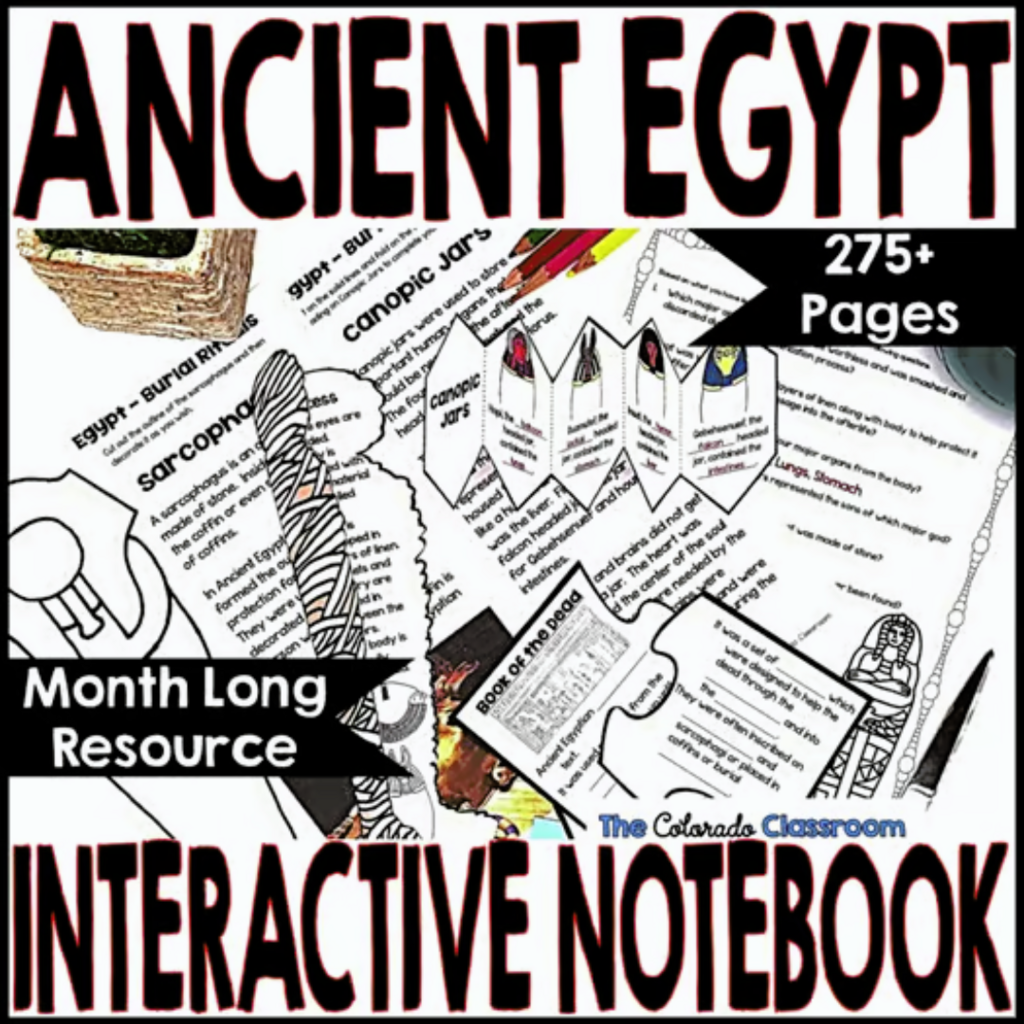
By intertwining engaging activities, discussions, and personalized reflections, these Ancient Egypt teaching resources breathe life into the unit. Through these hands-on resources, Ancient Egypt ceases to be a mere chapter in a textbook. Instead, it becomes a living adventure, inspiring curiosity, critical thinking, and a lifelong love for the past.
Looking for More?
Check out these other posts for more fun and engaging Social Studies lessons your students will love!
- 3 Powerful Simulations That Get Kids Hooked On History
- History Interactive Notebooks in the Modern Classroom
- Teaching the Civilizations of Ancient Mesopotamia through Fun Activities
Save these Ancient Egypt Teaching Resources for Later
Remember to save this post to your favorite history Pinterest board for when you are ready to use Ancient Egypt teaching resources in your unit!



